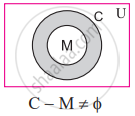Advertisements
Advertisements
प्रश्न
Express the truth of the following statement by the Venn diagram.
Some members of the present Indian cricket are not committed.
उत्तर
U : The set of all human beings.
M : The set of all members of the present Indian cricket.
C : The set of all committed members of the present Indian cricket.

The above Venn diagram represents the truth of the given statement, i.e. C - M = Φ
APPEARS IN
संबंधित प्रश्न
Express the following statement in symbolic form and write its truth value.
"If 4 is an odd number, then 6 is divisible by 3 "
Write the dual of the following statements: (p ∨ q) ∧ T
Prove that the following statement pattern is a tautology : ( q → p ) v ( p → q )
If p : It is raining
q : It is humid
Write the following statements in symbolic form:
(a) It is raining or humid.
(b) If it is raining then it is humid.
(c) It is raining but not humid.
Show that the following statement pattern in contingency :
(~p v q) → [p ∧ (q v ~ q)]
State if the following sentence is a statement. In case of a statement, write down the truth value :
√-4 is a rational number.
Using the truth table prove the following logical equivalence.
(p ∨ q) → r ≡ (p → r) ∧ (q → r)
Using the truth table prove the following logical equivalence.
p → (q ∧ r) ≡ (p → q) ∧ (p → r)
Examine whether the following statement pattern is a tautology or a contradiction or a contingency.
[(p → q) ∧ ∼ q] → ∼ p
Examine whether the following statement pattern is a tautology or a contradiction or a contingency.
(p ∧ ∼ q) ↔ (p → q)
Examine whether the following statement pattern is a tautology or a contradiction or a contingency.
(∼ p → q) ∧ (p ∧ r)
(p ∧ q) → r is logically equivalent to ________.
Determine whether the following statement pattern is a tautology, contradiction, or contingency:
[(p ∨ q) ∧ ∼p] ∧ ∼q
Determine whether the following statement pattern is a tautology, contradiction, or contingency:
(p → q) ∧ (p ∧ ∼q)
Determine whether the following statement pattern is a tautology, contradiction or contingency:
[p → (q → r)] ↔ [(p ∧ q) → r]
Determine whether the following statement pattern is a tautology, contradiction or contingency:
(p ∧ q) ∨ (∼p ∧ q) ∨ (p ∨ ∼q) ∨ (∼p ∧ ∼q)
Determine whether the following statement pattern is a tautology, contradiction or contingency:
[(p ∨ ∼q) ∨ (∼p ∧ q)] ∧ r
Determine whether the following statement pattern is a tautology, contradiction or contingency:
(p → q) ∨ (q → p)
Examine whether the following statement pattern is a tautology, a contradiction or a contingency.
(p ∧ ~ q) → (~ p ∧ ~ q)
Prove that the following statement pattern is a tautology.
(~ p ∨ ~ q) ↔ ~ (p ∧ q)
Show that the following statement pattern is contingency.
(p → q) ↔ (~ p ∨ q)
Write the dual of the following:
~(p ∧ q) ≡ ~ p ∨ ~ q
Write the dual statement of the following compound statement.
Karina is very good or everybody likes her.
Write the negation of the following statement.
∀ n ∈ N, n + 1 > 0
Using the rules of negation, write the negation of the following:
(~p ∧ q) ∧ (~q ∨ ~r)
Write the converse, inverse, and contrapositive of the following statement.
If he studies, then he will go to college.
With proper justification, state the negation of the following.
(p ↔ q) v (~ q → ~ r)
With proper justification, state the negation of the following.
(p → q) ∧ r
Construct the truth table for the following statement pattern.
(p ∨ ~q) → (r ∧ p)
Determine whether the following statement pattern is a tautology, contradiction, or contingency.
[(p ∧ q) ∨ (~p)] ∨ [p ∧ (~ q)]
Determine whether the following statement pattern is a tautology, contradiction, or contingency.
[~(p ∨ q) → p] ↔ [(~p) ∧ (~q)]
Using the truth table, prove the following logical equivalence.
[~(p ∨ q) ∨ (p ∨ q)] ∧ r ≡ r
The false statement in the following is ______.
Write the dual of the following
(p ˄ ∼q) ˅ (∼p ˄ q) ≡ (p ˅ q) ˄ ∼(p ˄ q)
Write the dual of the following.
13 is prime number and India is a democratic country
Examine whether the statement pattern
[p → (~ q ˅ r)] ↔ ~[p → (q → r)] is a tautology, contradiction or contingency.
Which of the following is not true for any two statements p and q?
Using truth table verify that:
(p ∧ q)∨ ∼ q ≡ p∨ ∼ q
If p, q are true statements and r, s are false statements, then find the truth value of ∼ [(p ∧ ∼ r) ∨ (∼ q ∨ s)].
